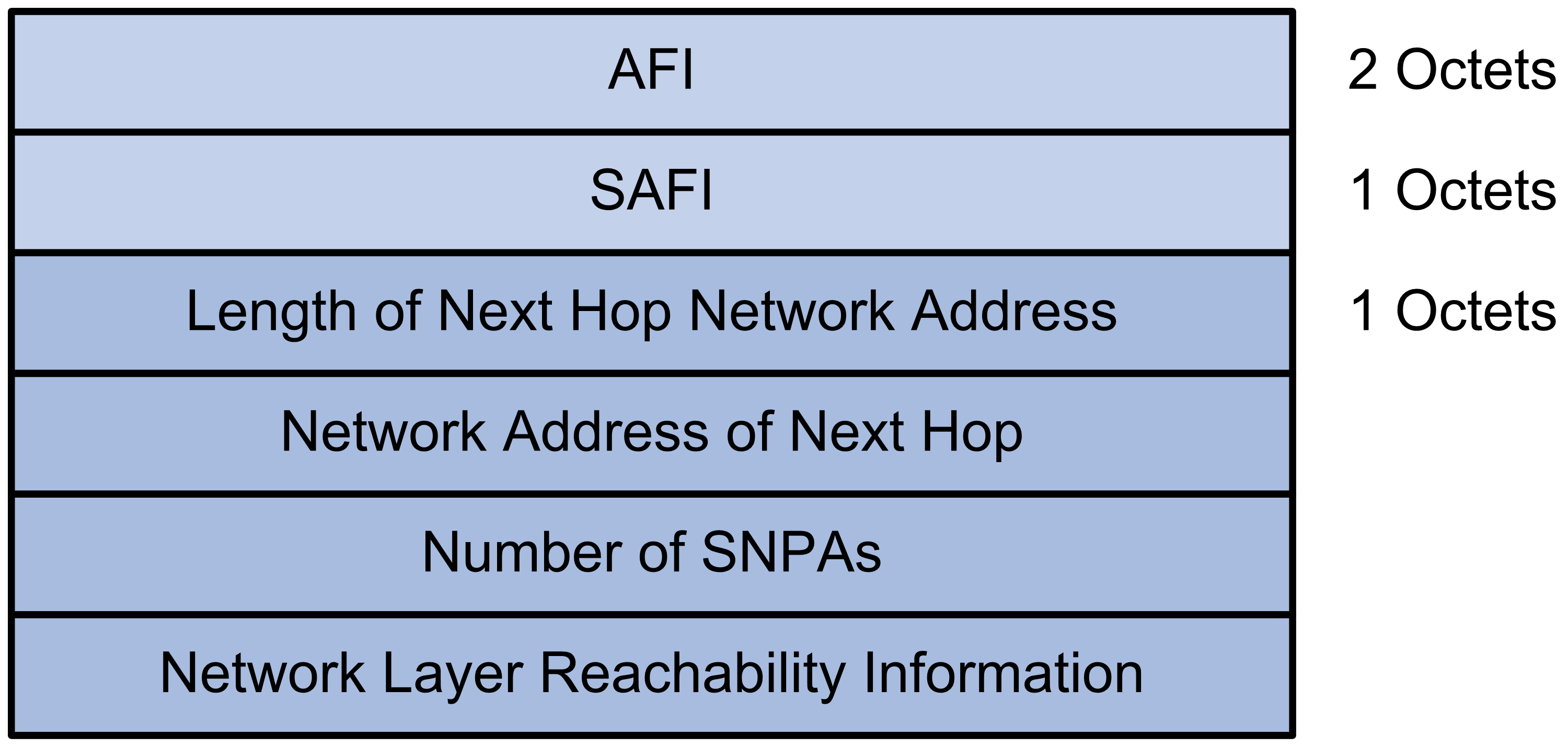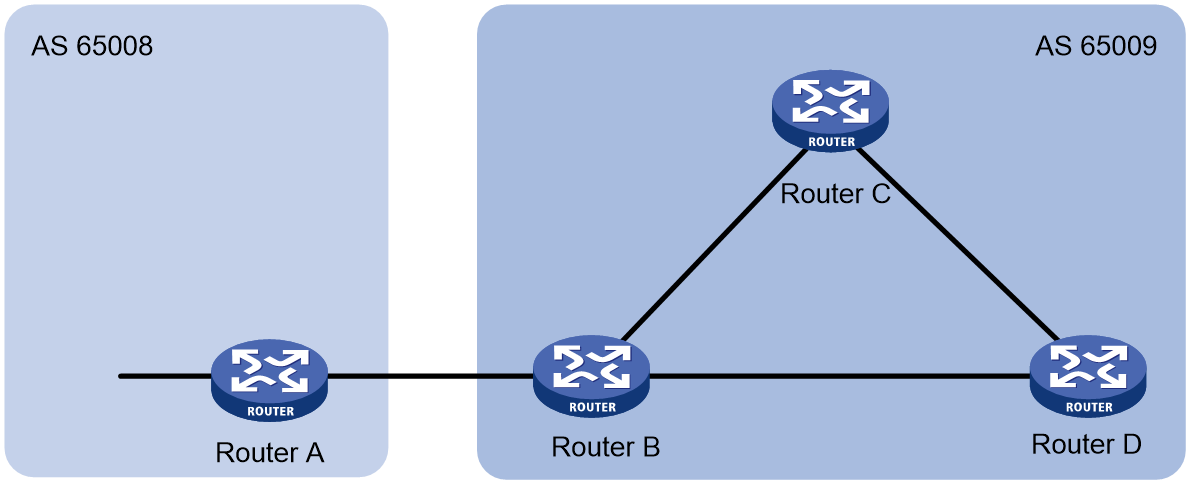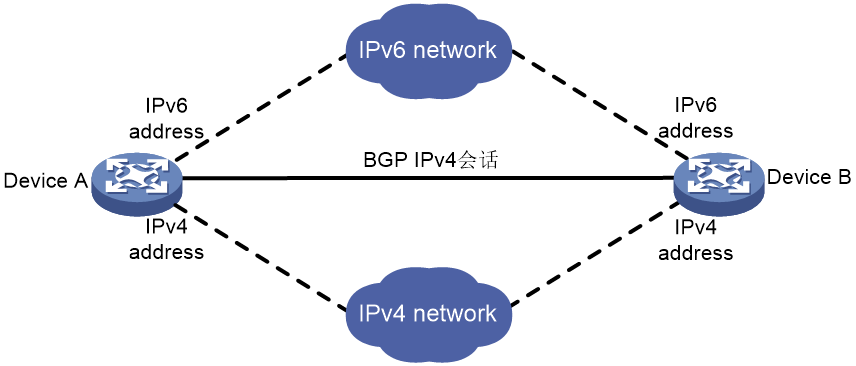- Released At: 12-05-2025
- Page Views:
- Downloads:
- Table of Contents
- Related Documents
-
|
|
|
|
|
IPv6 BGP Technology White Paper |
|
|
Copyright © 2021 New H3C Technologies Co., Ltd. All rights reserved.
No part of this manual may be reproduced or transmitted in any form or by any means without prior written consent of New H3C Technologies Co., Ltd.
Except for the trademarks of New H3C Technologies Co., Ltd., any trademarks that may be mentioned in this document are the property of their respective owners.
This document provides generic technical information, some of which might not be applicable to your products.
The information in this document is subject to change without notice.
Overview
BGP-4 was designed to carry only IPv4 routing information, and thus other network layer protocols such as IPv6 are not supported.
To support multiple network layer protocols, IETF extended BGP-4 by introducing Multiprotocol BGP (MP-BGP).
MP-BGP for IPv6 supports the same features and functionality as IPv4 BGP.
In this document, MP-BGP for IPv6 is referred to as IPv6 BGP for short.
MP-BGP extensions for IPv6
Extension considerations
BGP-4 carries IPv4 route information in update messages, including NLRI, NEXT_HOP and AGGREGATOR (AGGREGATOR contains the IP address and router ID of the BGP speaker generating the summary route).
To support IPv6, IPv6 BGP extends the NLRI and NEXT_HOP attributes in update messages as follows:
· Introduces two new route attributes, MP_REACH_NLRI and MP_UNREACH_NLRI, to replace the NLRI field of BGP-4 and provide IPv6 support.
· The NEXT_HOP attribute of IPv6 BGP is identified by an IPv6 unicast address or IPv6 local link address. Because the next hop information is a reachable route, it is carried in the MP_REACH_NLRI attribute rather than in the NEXT_HOP attribute.
Besides, IPv6 BGP is different from BGP-4 in that router IDs in BGP-4 can be configured manually or use the IPv4 addresses of interfaces. The router ID configuration of IPv6 BGP is similar to that of BGP-4, that is, IPv4 addresses are used as the router IDs in IPv6 BGP. In a pure IPv6 environment, you need to manually configure router IDs in IPv4 address format.
Introduction to extended attributes
The NLRI attribute of IPv6 BGP involves:
· MP_REACH_NLRI: Multiprotocol Reachable NLRI, for advertising reachable route and next hop information.
· MP_UNREACH_NLRI: Multiprotocol Unreachable NLRI, for withdrawal of unreachable routes.
These two attributes are both optional non-transitive, so BGP speakers not supporting multi-protocol ignore the two attributes and do not forward them to the peers. Routers supporting MP-BGP can communicate with routers not supporting MP-BGP.
The two extended attributes are introduced as follows:
Figure 1 Structure of MP_REACH_NLRI
The fields are described as follows:
· Address family identifier (AFI): Its value is 2, identifying the identity of the network layer protocol. This field indicates the IPv6 reachability information carried in the attribute.
· Subsequent Address Family Identifier (SAFI): Its value is 1, indicating that the IPv6 unicast reachability information is carried in the attribute.
· Length of Next Hop Network Address: Indicates the length of the next hop. A value of 16 means no local link address is included, while a value of 32 means a local link address is included.
· Network Address of Next Hop: Contains the address of the next hop on the path to the destination. A local link address may be contained in the field.
· Number of SNPAs: A 1-byte field. It is reserved and its value is 0.
· Network Layer Reachability Information: Carries IPv6 reachability information, including IPv6 prefixes.
Figure 2 Structure of MP_UNREACH_NLRI
The fields are described as follows:
· Address Family Identifier (AFI): Its value is 2, indicating the IPv6 unicast unreachability information is carried in the attribute.
· Subsequent Address Family Identifier (SAFI): Its value is 1, indicating the IPv6 unicast unreachability information is carried in the attribute.
· Network Layer UnReachability Information: Carries IPv6 unreachability information.
Application scenarios
Pure IPv6 network
In the pure IPv4 network as shown in Figure 3, every router communicates with each other through IPv4 BGP. If the network is changed into IPv6, all routers can run IPv6 BGP to ensure inter-AS communication..
6PE network
IPv6 provider edge (6PE) is a transition technology that uses MPLS to connect sparsely populated IPv6 networks through an existing IPv4 backbone network. It is an efficient solution for ISP IPv4/MPLS networks to provide IPv6 traffic forwarding capability.
Figure 4 Network diagram using 6PE
6PE mainly performs the following operations:
· 6PE assigns a label to IPv6 routing information received from a CE router, and sends the labeled IPv6 routing information to the peer 6PE device through an MP-BGP session. The peer 6PE device then forwards the IPv6 routing information to the attached customer site.
· 6PE provides tunnels over an IPv4 backbone so the IPv4 backbone can forward packets for IPv6 networks. The tunnels can be GRE tunnels, MPLS TE tunnels, or MPLS LSPs.
· Upon receiving an IPv6 packet, 6PE adds an inner tag (corresponding to the IPv6 packet) and then an outer tag (corresponding to the public network tunnel) to the IPv6 packet. Devices in the IPv4 backbone network forwards the packet based on the outer tag. When the peer 6PE device receives the packet, it removes the outer and inner tags and forwards the original IPv6 packet to the attached customer site.
With 6PE, the IPv4/MPLS network can provide access capability for isolated IPv6 networks only through IPv4/IPv6 dual stack on the PEs connecting to the IPv6 networks and relative configurations.
6PE has the following advantages:
· All 6PE relevant configurations are made on PEs, so customer IPv6 networks are unaware of the existence of the IPv4 network.
· 6PE can better utilize the existing MPLS network resources, so less reconstruction of the carrier’s network is required.
· PEs and CEs can use any existing IPv6 routing protocol.
· 6PE routers can provide multiple services for users, such as IPv6 and IPv4 VPN.
IPv6 route exchange between IPv4 peers
IPv6 route exchange between IPv4 peers enables an IPv4 network to support IPv6 BGP. To forward IPv6 traffic in an IPv4 network, you can directly enable IPv6 route exchange between IPv4 peers instead of establishing IPv6 sessions between BGP routers.
As shown in Figure 5, Device A and Device B can exchange both IPv4 and IPv6 routes once they have established a BGP IPv4 session.
Enabling IPv6 route exchange between IPv4 peers has the following advantages:
· Flexible control: Support for IPv6 BGP depends on the configuration of a BGP session. You can control the network scope that supports IPv6 traffic exchange as needed.
· Simple configuration: You only need to enable IPv4 BGP peers to exchange IPv6 routes.
· Little impact: You only need to modify the existing configuration instead of creating IPv6 sessions or deleting IPv4 sessions.
References
· RFC 2545: Use of BGP-4 MultiProtocol Extensions for IPv6 Inter-Domain Routing
· RFC 2858: MultiProtocol Extensions for BGP-4






